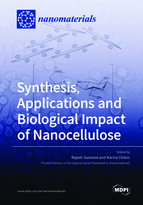Synthesis, Applications and Biological Impact of Nanocellulose
A special issue of Nanomaterials (ISSN 2079-4991). This special issue belongs to the section "Synthesis, Interfaces and Nanostructures".
Deadline for manuscript submissions: closed (30 April 2022) | Viewed by 23672
Special Issue Editors
Interests: nanochemistry; cellulose nanocrystals; surface modification; design of functional materials; synthesis; characterization; biomedical applications; vaccine nanoadjuvants
Special Issues, Collections and Topics in MDPI journals
Interests: redox biology; immune response; immunomodulation; cytotoxicity; vaccine adjuvants; cellulose nanocrystals; biomedical application of nanomaterials
Special Issue Information
Dear Colleagues,
Interest in nanocellulose research has continued to increase dramatically in the past few years with advances in the preparation/extraction of nanocellulose, such as cellulose nanocrystals (CNC), cellulose nanofibrils (CNF) and bacterial nanocellulose (BNC). There have also been significant developments in the fabrication of functional nanocellulose-based materials for various industrial applications. As a result of their excellent physical and biological properties, they have emerged as promising materials for biomedical applications, including tissue engineering and medical implants, therapeutic delivery systems and antimicrobial/antibacterial agents, among others. To move the nano biomedical field forward, it is crucial to develop a solid understanding of the biological impacts of nanocellulose, including toxicity and genotoxicity, as well as potential immune responses elicited by these nanomaterials.
This Special Issue aims to cover topics such as recent advances in the synthesis of nanocellulose, surface modifications for the design of functional nanocellulose as well as applications and biological impacts. Manuscripts presenting innovative methods of preparation, design of new advanced nanocellulose-based materials and biomedical applications are most welcome.
Dr. Rajesh SunaseeDr. Karina Ckless
Guest Editors
Manuscript Submission Information
Manuscripts should be submitted online at www.mdpi.com by registering and logging in to this website. Once you are registered, click here to go to the submission form. Manuscripts can be submitted until the deadline. All submissions that pass pre-check are peer-reviewed. Accepted papers will be published continuously in the journal (as soon as accepted) and will be listed together on the special issue website. Research articles, review articles as well as short communications are invited. For planned papers, a title and short abstract (about 100 words) can be sent to the Editorial Office for announcement on this website.
Submitted manuscripts should not have been published previously, nor be under consideration for publication elsewhere (except conference proceedings papers). All manuscripts are thoroughly refereed through a single-blind peer-review process. A guide for authors and other relevant information for submission of manuscripts is available on the Instructions for Authors page. Nanomaterials is an international peer-reviewed open access semimonthly journal published by MDPI.
Please visit the Instructions for Authors page before submitting a manuscript. The Article Processing Charge (APC) for publication in this open access journal is 2900 CHF (Swiss Francs). Submitted papers should be well formatted and use good English. Authors may use MDPI's English editing service prior to publication or during author revisions.
Keywords
- nanocellulose
- cellulose nanocrystals (CNC)
- cellulose nanofibrils (CNF)
- bacterial nanocellulose (BNC)
- synthesis of nanocellulose
- surface modifications
- characterization methods
- applications
- biological impacts (toxicity, genotoxicity, immunomodulation)








